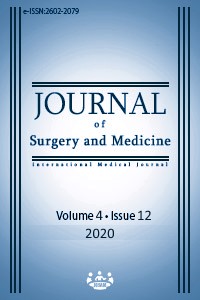Clinicopathological assessment in orchiectomy materials
Keywords:
Testis, Orchiectomy, Cryptorchidism, TumorAbstract
Aim: Orchiectomy indicates excising the testicles unilaterally or bilaterally. The causes of excision include primary etiologies such as torsion/infarction, infection, malignancy, cryptorchidism, and therapeutic castration secondary to prostate cancer. The aim of this study is to determine the clinicopathological characteristics of patients undergoing orchiectomy and obtain regional data. Methods: In this study, 316 orchiectomy specimen reports, stored in the archive of University of Health Science Turkey, Mehmet Akif İnan Training and Research Hospital, Pathology Laboratory between January 2015 and December 2019 were retrospectively evaluated. Histopathological diagnoses, right-left testicular localization, age range of patients and orchiectomy indication data were analyzed. Results: While the ages of 316 patients included in the study ranged from 1 to 88 years, the mean age was 26 years. Among the orchiectomy materials, undescended testis was the most common cause with 129 (40.8%) cases. Three hundred (94.9%) cases underwent unilateral and 16 (5.1%) cases underwent bilateral orchiectomy. Orchiectomy was performed in 58 cases aged between 14-68 years (mean age: 33 years), with a pre-diagnosis of a mass. Tumor sizes ranged from 0.4 cm to 16 cm. The average tumor size was 5.1 cm. Histopathologically, 51 (87.9%) cases were diagnosed with germ cell tumor. The most common diagnosis among germ cell tumors was classical seminomas (n=23 (45.1%)). Conclusion: Testicular orchiectomy surgery can be performed at any age depending on many different indications. Diagnoses vary from benign to malignant. Multiple sampling should be done to show the presence of GCNIS, which was highlighted in the last WHO 2016 classification, in testicular tumors, especially when diagnosing malignancy. Factors determining the prognosis such as lymphovascular invasion, rete testis invasion, and tumor size must be specified in the report.
Downloads
References
In Juan Rosai: Rosai and Ackerman’s Surgical Pathology 10th edition, Elsevier, Male reproductive system: Testis, 2011.pp.1334-74
Latheef DA, Nayak R, Nuzhath DT, Shetty DP, Nair DV. Histopathological Assessment of Orchidectomy Specimens in a Tertiary Care Center. International Journal of Innovative Research in Medical Science. 2019;4(03):183-7. doi:.10.23958/ijirms/vol04-i03/591
Sharma M, Mahajan V, Suri J, Kaul KK. Histopathological spectrum of testicular lesions- A retrospective study. Indian Journal of Pathology and Oncology. July-September 2017;4(3):437-41. 10.18231/2394-6792.2017.0094
Shanmugalingam T, Soultati A, Chowdhury S, Rudman S, Van Hemelrijck M. Global incidence and outcome of testicular cancer. Clin Epidemiol. 2013 Oct 17;5:417-27. doi: 10.2147/CLEP.S34430.
Park JS, Kim J, Elghiaty A, Ham WS. Recent global trends in testicular cancer incidence and mortality. Medicine (Baltimore). 2018 Sep;97(37):e12390. doi: 10.1097/MD.0000000000012390.
Stevenson SM, Lowrance WT. Epidemiology and Diagnosis of Testis Cancer. Urol Clin North Am. 2015 Aug;42(3):269-75. doi: 10.1016/j.ucl.2015.04.001.
Nwafor CC, Nwafor NN. Morphologic patterns of testicular lesions in Uyo: A university hospital experience. Sahel Med J. 2019;22:18-22.
Patel MB, Goswamy HM, Parikh UR, Mehta N. Histopathological study of testicular lesions. Gujarat Medical Journal. 2015;70(1):41-6.
Yalçınkaya U, Çalışır B, Uğraş N, Filiz G, Erol O, Testis tümörleri: 30 yıllık arşiv tarama sonuçları, Türk Patoloji Dergisi. 2008;24(2):100-6.
Bozkurt KK, Başpınar Ş, Akdeniz R, Bircan S, Koşar A. Testis tümörleri: 5 yıllık olgu serisi, Med J SDU / S.D.Ü. Tıp Fak. Derg. 2014;21(3):88-92.
Leman ES, Gonzalgo ML. Prognostic features and markers for testicular cancer management. Indian J Urol. 2010 Jan-Mar;26(1):76-81. doi: 10.4103/0970-1591.60450.
Williamson SR, Delahunt B, Magi-Galluzzi C, Algaba F, Egevad L, Ulbright TM, et al. The World Health Organization 2016 classification of testicular germ cell tumors: a review and update from the International Society of Urological Pathology Testis Consultation Panel. Histopathology. 2017 Feb;70(3):335-46. doi: 10.1111/his.13102.
Karabulut YY. Erkek Genital ve Üriner Sistem Kanserlerinde TNM Evrelemesinde Yapılan Değişiklikler. Güncel Patoloji Dergisi. 2018;2(2):57-63.
Facchini G, Rossetti S, Berretta M, Cavaliere C, D'Aniello C, Iovane G, et al. Prognostic and predictive factors in testicular cancer. Eur Rev Med Pharmacol Sci. 2019 May;23(9):3885-91. doi: 10.26355/eurrev_201905_17816.
Scandura G, Wagner T, Beltran L, Alifrangis C, Shamash J, Berney DM. Pathological risk factors for metastatic disease at presentation in testicular seminomas with focus on the recent pT changes in AJCC TNM eighth edition. Hum Pathol. 2019 Dec;94:16-22. doi: 10.1016/j.humpath.2019.10.004.
Warde P, Specht L, Horwich A, Oliver T, Panzarella T, Gospodarowicz M, et al. Prognostic factors for relapse in stage I seminoma managed by surveillance: a pooled analysis. J Clin Oncol. 2002;20:4448-52.
Evans AJ. An overview of recent WHO classification and AJCC pTNM staging changes for testicular neoplasms and their impact on the handling and reporting of orchidectomy specimens. Diagnostic Histopathology. 2018;24(6):pp.205-14. doi: 10.1016/j.mpdhp.2018.05.002
Pfannschmidt J, Hoffmann H, Dienemann H. Thoracic metastasectomy for nonseminomatous germ cell tumors. J Thorac Oncol. 2010 Jun;5(6 Suppl 2):S182-6. doi: 10.1097/JTO.0b013e3181dcf908.
Downloads
- 421 560
Published
Issue
Section
How to Cite
License
Copyright (c) 2020 Leymune Parlak, Emine Zeynep Tarini
This work is licensed under a Creative Commons Attribution-NonCommercial-NoDerivatives 4.0 International License.
















